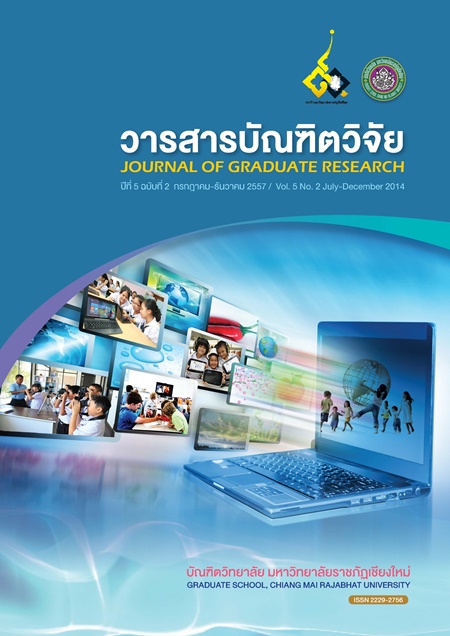ปัจจัยที่มีผลต่อการตัดสินใจเข้ารับการคัดกรองมะเร็งปากมดลูกของสตรี ในพื้นที่สถานการณ์ความไม่สงบ จังหวัดยะลา : อำเภอบันนังสตา
Main Article Content
บทคัดย่อ
การวิจัยครั้งนี้มีวัตถุประสงค์ (1) เพื่อศึกษาความสัมพันธ์ของปัจจัยส่วนบุคคล ปัจจัยด้านการรับรู้ที่มีผลต่อพฤติกรรม ด้านอิทธิพลของความสัมพันธ์ระหว่างบุคคล และด้านอิทธิพลของสถานการณ์ ที่มีผลต่อการตัดสินใจเข้ารับและที่ไม่เข้ารับการตรวจคัดกรองโรคมะเร็งปากมดลูก (2) เพื่อเปรียบเทียบปัจจัยที่มีผลต่อการตัดสินใจระหว่างสตรีที่เข้ารับและที่ไม่เข้ารับการตรวจคัดกรองโรคมะเร็งปากมดลูก กลุ่มตัวอย่างที่ใช้ในการศึกษา คือ สตรีวัยเจริญพันธุ์ที่มีอายุ 30-60 ปี ในอำเภอบันนังสตา จังหวัดยะลา ในช่วงปีงบประมาณ 2553–2556 จำนวน 391 คน แบ่งเป็นกลุ่มที่เข้ารับการตรวจคัดกรอง 107 คน และกลุ่มที่ไม่เข้ารับการตรวจคัดกรอง 284 คน เครื่องมือที่ใช้ในการรวบรวมข้อมูล คือ แบบสัมภาษณ์แบบเจาะลึกรายบุคคลและแบบสอบถาม ซึ่งมีทั้งหมด 4 ส่วน ประกอบด้วย ส่วนที่ 1 แบบสอบถามข้อมูลทั่วไป ส่วนที่ 2 แบบสอบถามปัจจัยด้านการรับรู้ ส่วนที่ 3 แบบสอบถามปัจจัยด้านอิทธิพลต่อการตัดสินใจ ส่วนที่ 4 ปัญหา อุปสรรค และข้อเสนอแนะ สถิติที่ใช้ในการวิเคราะห์ข้อมูล ได้แก่ สถิติร้อยละ สถิติ Chi-Square และ สถิติ t-test
ผลการวิจัยพบว่า ปัจจัยส่วนบุคคล ได้แก่ ศาสนา รายได้ มีความสัมพันธ์อย่างมีนัยสำคัญทางสถิติที่ระดับ 0.05 เว้นแต่ การรับข้อมูลข่าวสารจากเจ้าหน้าที่สาธารณสุข และระดับการศึกษา มีความ สัมพันธ์อย่างมีนัยสำคัญทางสถิติที่ระดับ 0.01 ปัจจัยด้านการรับรู้ที่มีผลต่อพฤติกรรม และ ปัจจัยอิทธิพลของสถานการณ์ มีความสัมพันธ์อย่างมีนัยสำคัญทางสถิติที่ระดับ 0.01 เมื่อพิจารณาถึงระดับการรับรู้และระดับอิทธิพลของสถานการณ์ที่แตกต่างกัน พบว่า การเข้ารับการตรวจคัดกรองและไม่เข้ารับการตรวจคัดกรองโรคมะเร็งปากมดลูกของสตรี แตกต่างกัน ส่วนระดับอิทธิพลระหว่างบุคคลที่แตกต่างกัน พบว่า การเข้ารับการตรวจคัดกรองและไม่เข้ารับการตรวจคัดกรองโรคมะเร็งปากมดลูกของสตรี ไม่มีความแตกต่างกันทางสถิติ กลุ่มที่เข้ารับการตรวจคัดกรองโรคมะเร็งปากมดลูก คิดเห็นว่าหลังหลังการเข้ารับการตรวจคัดกรองจะมีความวิตกกังวลหลังการทราบผลตรวจ ร้อยละ 73.83 ส่วนกลุ่มที่ไม่เข้ารับการตรวจคัดกรองโรคมะเร็งปากมดลูกนั้น ให้เหตุผลที่ไม่เข้ารับ เพราะไม่มีเวลา ร้อยละ 41.2 ไม่มั่นใจในกระบวนการตรวจและความวิตกกังวลหลังการทราบผลตรวจ ร้อยละ 38.03
FACTORS EFFECTED THE DECISION-MAKING IN CERVICAL CANCER SCREENING IN YALA, UNREST SOUTHERN PROVINCE : BANNANG SATA DISTRICT.
The aims of the research were 1) to study the connection between personality and, perceptual factors affecting behaviors, influenced by personal relationship and the influences of conditions affecting the decision to go for check up or not for cervical cancer 2) to compare factors affecting the decision to go for check up or not in cervical cancer. Random sample of 391 women in the aged of 30-60 years who lived in the Bannang Sata district, Yala province. This study lasted three years from 2010-2013. The sample group was divided into two groups 107 of tested women and 284 of untested women. The instruments used to collect the data were in-depth individual interview and questionnaires. The questionnaires were composed of 4 parts-the first part was general information, the second part was perceived factor, with .69 Kuder-Richardson (KR 20) relibility used, the third part was factors influencing decision making with .91 alpha Cronbach relibility used, and the fourth part was problems, obstacles and suggestions. The statistics used in data analysis were percentage, Chi-square and t-test.
Research shows that factors such as religion, income were signicantly correlated statistic with a level at .05. The information received from public health officers, and educational level had a correlation with statistically significant at level .01. The perceptual factor affecting behaviors and influencing condition had a correlation with statistically significant level at .01. It was found that having check up or not of cervical cancer have statistically significant difference of perception for the level of influence by different people, it was explored being screened and un screened cervical cancer by the women was not statistically different. The 73.83 percent of tested group of women viewed after being tested worried about the results. The reason why 41.2 percent of the untested women did not want to be screened, is because they had no free time moreover, 38.03 percent of them sensed unreliability on the screening process and worried about the result.


